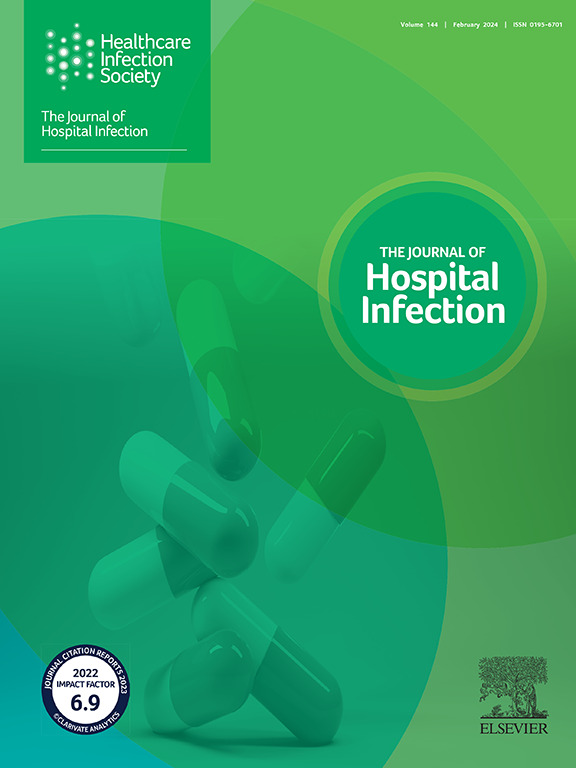2013 - 2022年两次国家健康登记中原发性全髋关节置换术后手术部位感染和假体周围关节感染的趋势
IF 3.9
3区 医学
Q1 INFECTIOUS DISEASES
引用次数: 0
摘要
本研究旨在评估2013年至2022年挪威原发性全髋关节置换术(THA)后手术部位感染(SSI)、SSI再手术和假体周围关节感染(PJI)再手术的趋势。使用两个国家健康登记来比较它们作为原发性THA后PJI监测工具的能力。2013年至2022年间,PJI的SSI和再开工率相应下降。与强制性的挪威医疗保健相关感染监测系统相比,在基于患者同意的挪威关节置换术登记册中,PJI 30天再手术的95%的完全性被认为是优秀的。研究结果表明原发性THA后SSI和PJI的发生率确实降低了。本文章由计算机程序翻译,如有差异,请以英文原文为准。
Trends in surgical site infection and periprosthetic joint infection after primary total hip arthroplasty in two national health registers 2013–2022
Background
This study aimed to assess trends in surgical site infection (SSI), re-operations for SSI, and re-operations for periprosthetic joint infection (PJI) following primary total hip arthroplasty (THA) in Norway from 2013 to 2022. Two national health registers were used to compare their abilities as surveillance tools for PJI after primary THA.
Methods
The Norwegian Surveillance System for Healthcare-Associated Infections (NOIS) was evaluated for 30-day incidence and risk of SSI and reoperations for SSI after THA. Reporting to NOIS is mandatory. The Norwegian Arthroplasty Register (NAR) was assessed for 30-day and 1-year incidence and risk of re-operation due to PJI after THA. Reporting to NAR is based on patient consent. Descriptive statistics and adjusted Cox regression analyses, accounting for sex, age and American Society of Anesthesiology class, were performed.
Results
A total of 87,923 primary THAs were included in NOIS, with 1393 (1.6%) reported as 30-day SSIs. The 30-day re-operation rate for SSI in NOIS was 0.9% (N = 765), with 96% completeness of 30-day follow-up. In NAR, out of 91,194 THAs, the 30-day re-operation rate for PJI was 0.8% (N = 725) and the 1-year rate was 1.2% (N = 1019). The completeness of 30-day re-operation for PJI in NAR compared with re-operation for SSI in NOIS was 95%. Annual risk factors were similar across registers. There was a corresponding decline in SSI [adjusted hazard rate ratio (aHRR) 0.92, 95% confidence interval (CI) 0.90–0.93] and reoperations for SSI (aHRR 0.95, 95% CI 0.92–0.97) in NOIS, and reoperations for PJI (30 days: aHRR 0.96, 95% CI 0.94–0.99; 1 year: aHRR 0.95, 95% CI 0.95–0.99) in NAR.
Conclusion
There has been a corresponding decline in SSI and re-operation for PJI between 2013 and 2022. The 95% completeness of 30-day re-operation for PJI in the patient-consent-based NAR, compared with the mandatory NOIS, is considered excellent. The findings indicate a genuine reduction in the incidence of SSI and PJI after primary THA.
求助全文
通过发布文献求助,成功后即可免费获取论文全文。
去求助
来源期刊

Journal of Hospital Infection
医学-传染病学
CiteScore
12.70
自引率
5.80%
发文量
271
审稿时长
19 days
期刊介绍:
The Journal of Hospital Infection is the editorially independent scientific publication of the Healthcare Infection Society. The aim of the Journal is to publish high quality research and information relating to infection prevention and control that is relevant to an international audience.
The Journal welcomes submissions that relate to all aspects of infection prevention and control in healthcare settings. This includes submissions that:
provide new insight into the epidemiology, surveillance, or prevention and control of healthcare-associated infections and antimicrobial resistance in healthcare settings;
provide new insight into cleaning, disinfection and decontamination;
provide new insight into the design of healthcare premises;
describe novel aspects of outbreaks of infection;
throw light on techniques for effective antimicrobial stewardship;
describe novel techniques (laboratory-based or point of care) for the detection of infection or antimicrobial resistance in the healthcare setting, particularly if these can be used to facilitate infection prevention and control;
improve understanding of the motivations of safe healthcare behaviour, or describe techniques for achieving behavioural and cultural change;
improve understanding of the use of IT systems in infection surveillance and prevention and control.
 求助内容:
求助内容: 应助结果提醒方式:
应助结果提醒方式:


